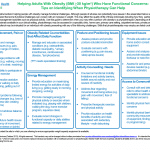Ever seen an old-school ad for a discount appliance or furniture store that said “inconveniently located, but worth the trip!”?
It turns out health and wellness businesses have something to learn from those guys.
A few months ago, what looked like a great little business opened up not far from our office. Their name was pretty forgettable, along the lines of “endurance athlete”, and when I went there on a lark, they had a decent selection of better brands you don’t always see locally, like two-piece DeSoto wetsuits, plus some legit ultrarunning hydration vests, serious running shoes, and more.
So they were totally worth the trip. But they were in a truly terrible location. Zero visibility from passing traffic, even for customers of other businesses in the same mall. They were practically invisible. It was sheer luck we noticed them.
Location, location… it’s not location, OK?
Your health and wellness business can be literally in the armpit of a strip mall, miles away from good traffic flow, between a cigar store and an all-night pizza delivery outfit, and still succeed.
IF it’s a destination.
But it will never BE a destination if nobody knows about it.
Which is why my great little local endurance shop was toast within just a few months.
These are the mistakes they made that you should avoid:
No marketing budget after the grand opening
We did see a few social media and Google Ads right after they opened. Then, crickets.
A lot of businesses make the mistake of spending all their marketing money on grand openings, expensive media outlets, or giveaways they can’t sustain. When the ads (and the money for giveaways) disappear, so does the store’s marketing.
By the time people really know you exist, by the time you’re top of mind, we’re talking at least months after your opening, and realistically longer to really build awareness.
So you have to budget for the long haul. You have to be able to keep advertising.
Maybe that means you need to cut back on the TV ads or the giant inflatable gorilla or the 6-months-no-membership-fees offers.
Instead, nail down your local marketing triangle:
- First, nail down your website optimization.
- Then, optimize the heck out of every single Google My Business feature.
- Then, turn your limited budget to paid online advertising.
Focus on Google Ads, Facebook Ads, and promoted social posts. Use geographic radius targeting in your search marketing so you don’t waste your limited budget on telling everyone south of the Red River up by Oklahoma that you just opened up a shop in Plano, TX nearly 100 miles away. Update your Google MyBusiness listing with accurate hours, and pictures of your business.
All of these advertising platforms cost pennies on the dollar and the return is usually disproportionately high.
Meanwhile, develop relationships with industry experts, key personalities, media channels, online fans and locals who will chat up your fitness or wellness business. They may not pay off right away, but the investment is small and the potential, great.
Don’t overlook signage or settle for the bare minimum – a sign above your storefront in the middle of a strip mall.
Ask your landlord if there are options you’re not thinking about for increasing visibility of your business. They may cost extra, but not being visible will cost you even more. Balloons, pennants and more – do whatever you need to do to grab attention from every single person in your vicinity who might be interested.
To sum: make sure your advertising and marketing dollars can cover the time it takes prospects to stumble over your business Otherwise, they may never notice you — and meanwhile, you’re digging a deeper and deeper financial hole.
No budget for continued operations
We watched them closely to see how things would unfold. Pretty soon, they were cutting back hours and cutting back on their specialty inventory.
Your wellness business needs money to last. While your marketing campaign is slowly taking off, you need to pay salaries, buy supplies, maintain equipment, keep the lights on, and possibly stock inventory. If you’re selling product that’s seasonal, has an expiration date, or is otherwise likely to not be sellable in a month, you’ll have to KEEP paying for product that isn’t selling while you’re trying to get the first customers to walk through the door.
Again, start small and ramp up. You don’t need a splashy grand opening. You don’t need crazy sales to attract people. Your store isn’t even visible from the street (remember?)
You need people to know you’re there.
Hordes won’t walk through the door on day 1. You can run a little low on inventory as long as you have enough for the “early” folks who’ve just discovered you. It’s more important that you have good selection, fantastic service with excellent follow-up, and a flair for problem solving. If your walk-in can’t find what they’re looking for, find out how to get it to them and don’t stop until you do.
If it’s a service you don’t have or haven’t started yet, solicit their feedback and make them one of the charter customers. Their investment in influencing how your business delivers to customers like them will pay off in word-of-mouth, and it’s also a bellwether for the type of customer you’ll continue to attract.
Take it a step at a time, adjust your business to continue serving the customers you actually have, and grow slowly.
That way, you avoid spending money on customers who will never be yours, and the money you do spend will go farther.
No business partnering or community outreach
There were a zillion opportunities for them to piggyback on the marketing of likeminded better-established businesses, but they never took advantage of them.
If your wellness business is in a horrible location, one of the smartest (and cheapest) things you can do is to get out into the community and Get Visible! Offer post-ride stretch classes at the biggest local bike shop. Yoga or kickboxing classes in a city park (remember to get a permit if you need one!), volunteering, goodie bag stuffing or sponsoring some runners at a 5K, or helping a charity are all great ways to let the world know your fitness brand is right there in the community. Customers may literally not know you’re a block away, right around the corner, until they see you walking around.
Think about getting out OF the community, too. Do events at other more visible places and use an offer (judiciously) that will get people to find you. The more specialized your products and services are, the likelier people are to be willing to travel to get them.
Finally, partner with complementary businesses and co-market with them. Think outside the wellness box. For instance, that 24-hour pizza joint that’s right next door? What would it be worth to them to create a few of their deep-dish Chicago-style pizzas for your New Members Welcome Party? Selfie Saturday (prizes to one lucky winner who hashtags the pizza joint in the photo)? And so on.
Ineffective social presence
Speaking of hashtagging, how effective is your social presence?
Organic posts on Facebook and Instagram business pages just don’t move the needle. Generally, only people who already follow you will see those posts (and often, not even them).
When your biggest problem is awareness, this scenario is a recipe for disaster, so paid ads and promoted posts are the smarter social media play.
By the way, this is the perfect time to mine those photos (you did take them, right?) from the 5K, pizza night, the kickboxing class in the city park, or Selfie Saturday. Instagram the heck out of those! Don’t just post to your Facebook page; use Facebook to link your club’s page to groups that share an interest, and when you post, those groups will see your posts. Watch engagement on posts. Respond to people who like or reply to your posts. Promote the most active posts.
Get involved in online communities that would welcome weigh-in from your brand. Set up a display outside the store that doesn’t cost the earth to put up for weeks on end. Make sure you’ve got an email sign-up page on your website so you can collect leads from qualified prospects (see our article about email as “dark social”) and actually send emails (grin).
Set up a Yelp Call To Action button. It’s free, and so few businesses remember to do it that you can gain a little advantage!
Finally, ask happy customers to tell their friends, recommend you on Facebook, Google reviews, and Yelp. Encourage reviews methodically, over and over. It’s not a one-time ask.
Shoot Facebook Live and other video video, talk about what’s going on at the store, and even make fun of your location. Be quirky. Be happy. Be excited. It’s contagious.
Most of all, be public and visible.
Hapless affinity marketing
Yep, people seek out well-known brands. But they will not seek our your business just because you put all those brand logos on your website. Similarly, just listing general service categories (“personal training” or “nutrition coaching”, for example) does nothing to command attention from potential customers.
Why does this matter? Because if your location is out-of-the-way, it has to be really special: some place people would willingly drive to even though it isn’t convenient or obvious.
Our little local “endurance store” offered something I really cared about: two-piece semi-professional quality wetsuits from a specific hard-to-find brand that I really liked, AND specialized ultra endurance running gear. At the time, I made a mental note to come back. I gave them my email address. I got the manager’s name and the store’s phone number.
But then I never heard from them again, never got a single email. So they didn’t stay top of mind.
When I got ready to pull the trigger on a new wetsuit, I ended up searching out the wetsuit maker’s site and buying directly, and I found an online ultrarunning community whose members had lots of detailed gear recommendations. Their suggestions went far beyond what my little local store had.
And yet, if they had stayed in touch, I would have almost certainly bought my wetsuit and other gear there.
I never would have had a reason to look more broadly.
By the next time I noticed them, they were out of business.




